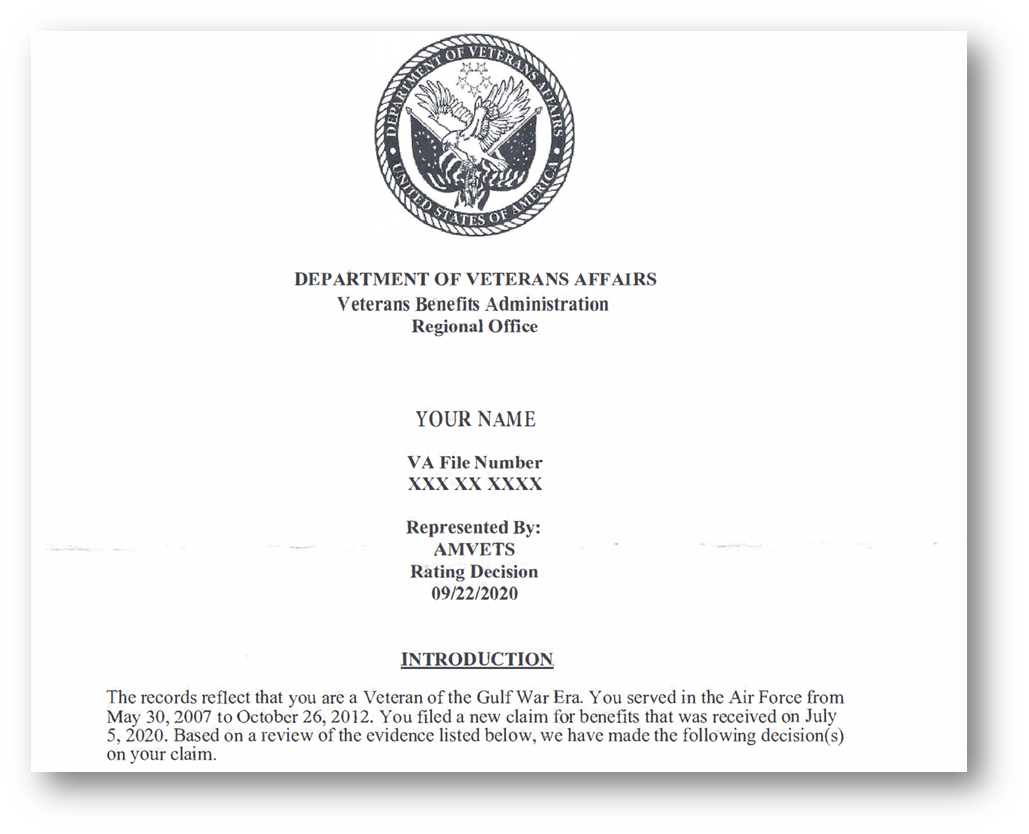Looking for Expert-Level VA Claim Answers?📱Call Us Now! 737-295-2226
Today, we’ll answer an important question: “How Do I Know If My VA Claim Was Approved?”
There are several signs you can look for as well as two primary places you can check to see if your VA claim was either approved, denied, or deferred.
In this article, we’ll explore how to check your VA claim status online at each step in the VA disability claim process as well as the two ways to check for a VA claim approval.
Without further ado, let’s begin!
Table of Contents
Summary of Key Points
- Two Ways to Know If Your VA Claim Was Approved: You can check your combined and individual VA disability ratings on VA.gov once the status changes to “decision notification sent” or by reading your VA rating decision letter, which usually arrives by mail 7-10 days after the status update. VA decision letters are also available online at VA.gov.
- Importance of the VA Rating Decision Letter: The VA decision letter provides detailed explanations for the approval, denial, or deferral of your claim. Reviewing the sections marked “Evidence” and “Reasons for Decision” is crucial, especially if you plan to file an appeal.
- VA Disability Claim Steps: The VA disability claim process consists of 8-steps, each designed to ensure a thorough and fair evaluation of your evidence, guiding the claim from submission to decision. VA claims are taking roughly 150 calendar days to complete from beginning to end.
- Appealing a Denied VA Claim: If you disagree with the VA’s decision on your claim, don’t panic—review your decision letter carefully to understand the reasons for denial. You can start an appeal by filing a Higher-Level Review (HLR) or a Supplemental Claim, depending on the circumstances. If denied again, you can pursue a Board Appeal or request another HLR of the Supplemental Claim with additional evidence.
How Do I Know If My VA Claim Was Approved?
There are two main ways to check if your VA claim was approved:
#1. VA.gov View Your VA Disability Ratings

Once your VA claim status changes to “decision notification sent,” you can check your VA.gov account to see if your combined rating and individual ratings changed.
Sign into VA.gov and click the link under your name at the top of the screen next to “your VA disability rating.”
This will allow you to view your VA disability ratings and effective dates.
This is the fastest and easiest way to know if your VA claim was approved.
If the ratings didn’t change, it’s likely that your VA claim was either denied or deferred.
But, you won’t know for sure until you get a copy of your VA rating decision letter.
#2. Read Your VA Rating Decision Letter

7-10 calendar days after your claim status changes to “decision notification sent,” you’ll get a copy of your VA rating decision letter sent to you in the mail.
This letter is mission critical because it explains the VA’s rationale for either approving, denying, or deferring your VA claim.
It’s very important to review your VA decision letter in-detail, especially the section headers marked “Evidence” and “Reasons for Decision.”
Why?
Because if you disagree with some or all the VA’s decision, you need to know specific areas of evidence reviewed or not reviewed to include the C&P examiner’s opinion or any flawed logic applied by the VA Rater so you can file an appeal (Higher Level Review, Supplemental Claim, or Board Appeal).
You can also view and download copies of your VA rating decision letters online by clicking here.
What Does It Mean to Have Your VA Claim Deferred?
A deferred VA claim means that the VA needs more information before making a final decision on your claim.
This status indicates that your claim is neither approved nor denied; instead, the VA has put the claim on hold while they seek additional evidence.
There are a few common reasons why a VA claim might be deferred:
- Additional Evidence Required: The VA may need more medical records, service treatment records, or specific details related to your condition. This could include requesting further documentation from you or scheduling a new Compensation & Pension (C&P) exam.
- Clarification of Existing Information: If the information in your file is unclear or incomplete, the VA may defer your claim to obtain clarification, either through additional records or further statements.
- Missing Documentation: Sometimes, essential documents such as medical records, DD 214, or proof of an in-service event might be missing from your file. The VA will defer the claim until these documents are provided.
During a deferred status, the claim goes back to the “Evidence Gathering” stage, and you will be notified if any action is required on your part.
It’s super important to respond promptly to any VA requests to avoid further delays!
How Can I Check the Status of My VA Claim or Appeal?
It’s easier than ever to check your VA claim status and you can now do it all online at VA.gov.
Here’s how:
Log in to Your VA.gov Account
- Sign into your VA.gov account.
- Once logged in, you’ll be able to view the status of your claims and appeals, see any updates, and download decision letters if available.
- Click this link to check your VA claim status online.
Need More Help?
- If you have any issues or need further help, you can call the VA directly at 1-800-827-1000 (TTY: 711), Monday through Friday, from 8:00 a.m. to 9:00 p.m. ET.
What Do Each of the VA Claim Steps Mean and How Long Do They Take?
Here’s a chart detailing the steps in the VA claim process along with the expected timelines:
| VA Claim Step | Description and Action | Timeline |
|---|---|---|
| Step #1: Claim Received | The VA acknowledges receipt of your disability claim. | 7 to 14 days |
| Step #2: Under Review | The VA reviews your claim to ensure all necessary information is included and understands the specifics of your case. | 14 to 30 days |
| Step #3: Gathering of Evidence | The VA collects evidence to support your claim, possibly requesting additional information from various sources. This is the longest step in the VA disability claim process. | 30 to 60 days |
| Step #4: Review of Evidence | The VA reviews all gathered evidence to assess the validity and extent of your disability claim. | 7 to 14 days |
| Step #5: Preparation for Decision | The VA prepares to make a decision on your claim based on the evidence and reviews. | 7 to 14 days |
| Step #6: Pending Decision Approval | A senior VA official reviews the decision to ensure accuracy and compliance with regulations. | 7 to 14 days |
| Step #7: Preparation for Notification | The VA prepares your decision packet, including details on the decision, disability rating, and any benefits. | 7 to 14 days |
| Step #8: Decision Notification Sent | The final step involves sending your decision packet by U.S. mail, detailing the decision and options if you disagree. | 7 to 10 days |
What If I Disagree With the VA’s Decision on My VA Disability Claim?
It feels like a gut-punch to have your VA claim denied, and I’ve personally experienced this disappointment numerous times.
First things first, don’t panic; the VA claim process is never over unless you quit!
You should immediately review your VA decision letter to understand why your claim was denied.
You’ve got a couple good options to start with to appeal a denied VA claim: VA Higher Level Review (HLR) or VA Supplemental Claim.
If you believe your claim was denied due to an administrative error, consider filing a Higher Level Review (HLR).
VA HLR Tips:
- You’ll have the option (not required) for an informal phone conference with a more senior-level claims adjudicator, where you can explain your situation and advocate for yourself.
- Be sure to refer to your submitted medical evidence and stick to the facts.
- Many claims are overturned during the HLR appeals process!
What If My VA Higher-Level Review Gets Denied?
If your HLR is denied, the next step is to file a Supplemental Claim.
The key difference between an HLR and a Supplemental Claim is that you can submit new and relevant evidence with a Supplemental Claim.
This can help address gaps in your service treatment records or provide new medical evidence to support your claim.
VA Supplemental Claim Tips:
- If denied due to lack of evidence of a disability, submit new medical records with a current diagnosis.
- If denied for lack of service connection, obtain a new Nexus Letter and include it with your Supplemental Claim.
- If your rating is lower than expected, submit new medical evidence that clearly documents the severity of your symptoms. A Disability Benefits Questionnaire (DBQ) from a private provider can be helpful in demonstrating the severity of your symptoms.
What If My Supplemental Claim Gets Denied?
If your Supplemental Claim is denied, you can request an HLR on the denied Supplemental Claim.
A more senior adjudicator will review the Supplemental Claim denial for any errors.
If this is also denied, you have the option to pursue a Board Appeal.
For faster results, consider a “records-only” Board Appeal, which is assigned to a judge and generally results in a quicker decision.
YOU SERVED. YOU DESERVE. We Got Your Six!

- VA Claims Insider is the #1 most trusted name in VA disability claims.
- Work directly with a VA claims coach who can help lead you to VA claim victory.
- 25,000+ disabled veterans served in our membership programs since 2016.
- 30% average rating increase for veterans who complete our #1 rated Elite program.
- 4.7/5.0 average rating out of 5,500+ total reviews; over 4,500 5-star reviews.
About the Author

Brian Reese
Brian Reese is a world-renowned VA disability benefits expert and the #1 bestselling author of VA Claim Secrets and You Deserve It. Motivated by his own frustration with the VA claim process, Brian founded VA Claims Insider to help disabled veterans secure their VA disability compensation faster, regardless of their past struggles with the VA. Since 2013, he has positively impacted the lives of over 10 million military, veterans, and their families.
A former active-duty Air Force officer, Brian has extensive experience leading diverse teams in challenging international environments, including a combat tour in Afghanistan in 2011 supporting Operation ENDURING FREEDOM.
Brian is a Distinguished Graduate of Management from the United States Air Force Academy and earned his MBA from Oklahoma State University’s Spears School of Business, where he was a National Honor Scholar, ranking in the top 1% of his class.



